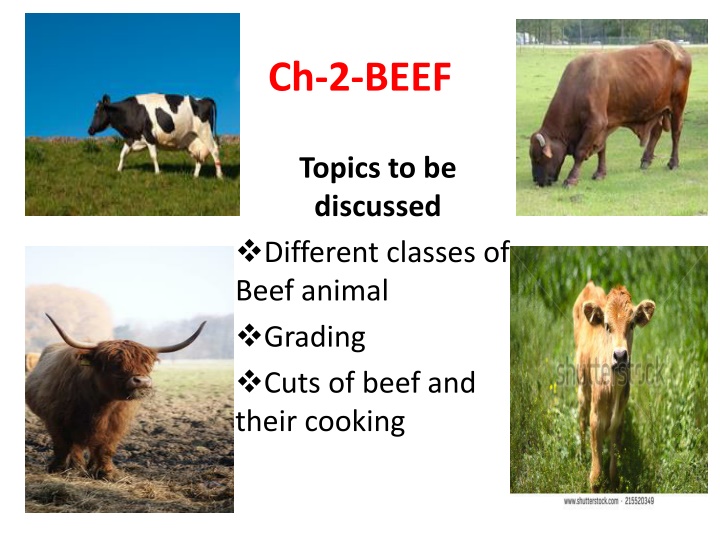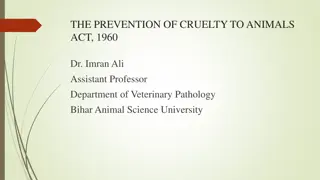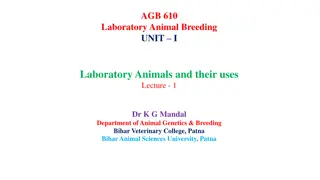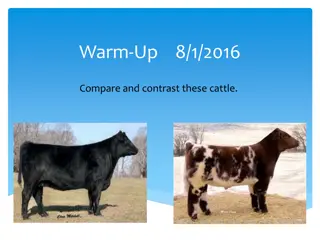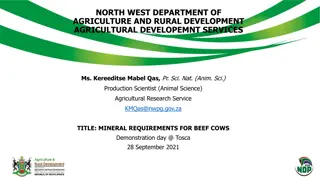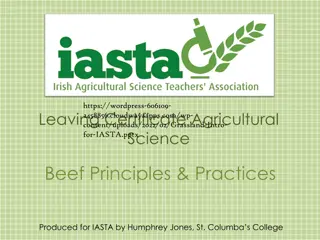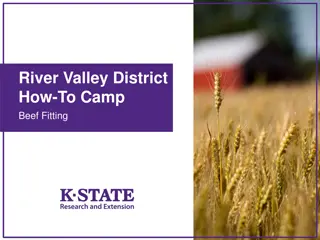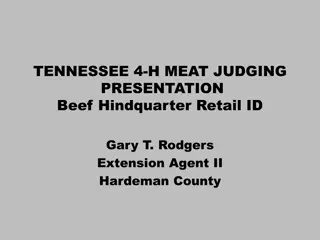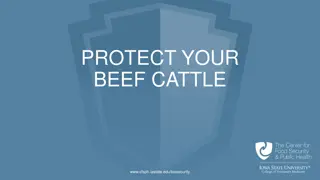Different Classes of Beef Animals and Their Grading
Different classes of beef animals, including cow, bull, calf, ox, heifer, and more, are discussed along with their characteristics and purposes. The process of grading beef, which provides information on taste and palatability, is also explained. Additionally, cuts of beef and their cooking methods are explored in detail.
Download Presentation

Please find below an Image/Link to download the presentation.
The content on the website is provided AS IS for your information and personal use only. It may not be sold, licensed, or shared on other websites without obtaining consent from the author.If you encounter any issues during the download, it is possible that the publisher has removed the file from their server.
You are allowed to download the files provided on this website for personal or commercial use, subject to the condition that they are used lawfully. All files are the property of their respective owners.
The content on the website is provided AS IS for your information and personal use only. It may not be sold, licensed, or shared on other websites without obtaining consent from the author.
E N D
Presentation Transcript
Ch-2-BEEF Topics to be discussed Different classes of Beef animal Grading Cuts of beef and their cooking
Different classes of beef animal Mostly the beef animal is called and identified in the name such as Cattle or Bovine There are many people worldwide who think they know what cattle look like but cannot properly tell the difference between a cow, bull, steer or heifer.
Contd. Cow: a mature female bovine that has given birth to at least one or two calves. Bull: a mature, intact (testicles present and not removed) male bovine used for breeding purposes. Cattle: general plural term for more than one bovine Calf (plural: Calves): an immature bovine (male and female) that is reliant on milk from its dam or from a bottle in order to survive and grow. A calf is known as such from birth to around 10 months of age.
Contd.. Ox (plural: Oxen): a bovine that is trained for draft work (pulling carts, wagons, plows, etc.)This is a term that primarily refers to a male bovine that has been castrated after maturity. However, an ox can also be female bovine (cow or heifer) or even a bull that has been trained for the same purpose. Steer: a male bovine (or bull) that has been castrated before reaching sexual maturity and is primarily used for beef. Stag: a male bovine (or bull) that has been castrated after or upon reaching sexual maturity and is primarily used for beef.
Contd.. Heifer: a female bovine (often immature, but beyond the "calf" stage) less than 1 to 2 years of age that has never calved. Such females, if they've never calved beyond two years of age may also be called heiferettes. Bred Heifer: a female bovine that is pregnant with her first calf. First-calf Heifer or First-calver: a female bovine that has given birth to her first calf, and is often around 24 to 36 months of age, depending on the breed and when she was first bred.
Contd.. Bull calf: an immature intact male bovine (since all males are born with testes) that is reliant on milk from his dam or a bottle for growth and survival. Steer calf: an immature male bovine that has been castrated a few days to a couple months after birth, and is reliant on milk from his dam or a bottle for growth and survival. Heifer calf: an immature female bovine that is reliant on milk from her dam or a bottle for growth and survival.
GRADING Voluntary service paid by meat processors; cost is passed on to consumers in price Provides information relating to taste/palatability of meat
GRADING A. Factors Affecting Meat Grades 1. Marbling 2. Age of Animal 3. Texture 4. Appearance 5. Conformation- amount of bone/lean 6. Cutability- amount of fat/lean
USDA GRADES Prime Well marbled Firm texture Bright color Limited supply Sold to better restaurants
USDA GRADES Choice Slightly less marbling than Prime Most in demand by consumers
USDA GRADES Select Less fat/older animal Less juicy Less flavorful For thrifty shoppers
USDA GRADES Standard/Commercial Not found in commercial outlets Used in processed meats
Dissection-Cuts of Beef Wholesale Beef Cuts: Blue=Locomotion Muscles Green=Suspension Muscles SHORT SIRLOIN RIB LOIN CHUCK ROUND SHORT PLATE FORESHANK & BRISKET FLANK
TYPES OF CUTS Wholesale Cuts- large subdivisions sent to grocery stores for further cutting
TYPES OF CUTS Retail Cuts- individual cuts of meat sold to consumers
COOKING METHODS A. Moist Heat Methods (locomotion muscles/tough cuts) 1. Braising 2. Cooking in a Liquid (simmering/stewing) Wholesale Cuts- (chuck, foreshank and brisket, short plate, flank, round)
COOKING METHODS B. Dry Heat Methods- Suspension Muscles/Tender Cuts 1. Roasting 2. Broiling 3. Pan-broiling 4. Pan-frying 5. Stir-frying Wholesale Cuts- (Rib, Short Loin, Sirloin)
HEALTHY COOKING TIPS Choose cuts from the round and loin sections Limit portion sizes to two 3-ounce servings per day Trim all visible fat before cooking Broil or grill meats Use non-stick pans when frying and browning Skim fat from surface of chilled meat soups and stocks
Thank you.!!!! For your attention Chapter-2 is completed Are you happy? Get ready for the first Quiz
